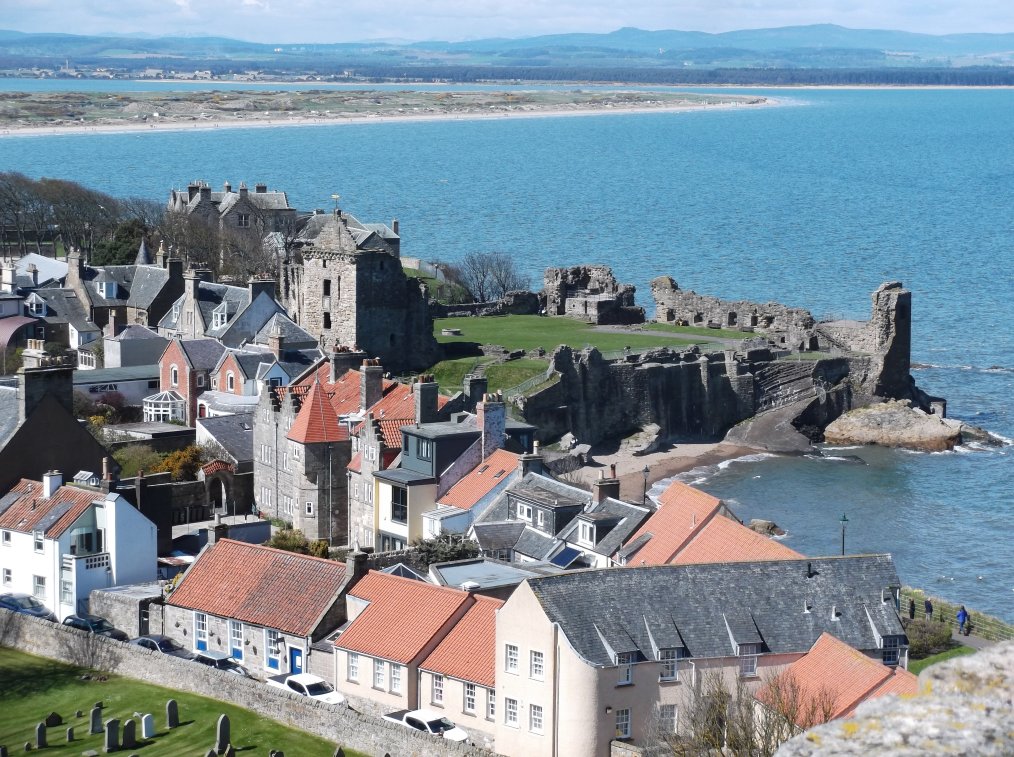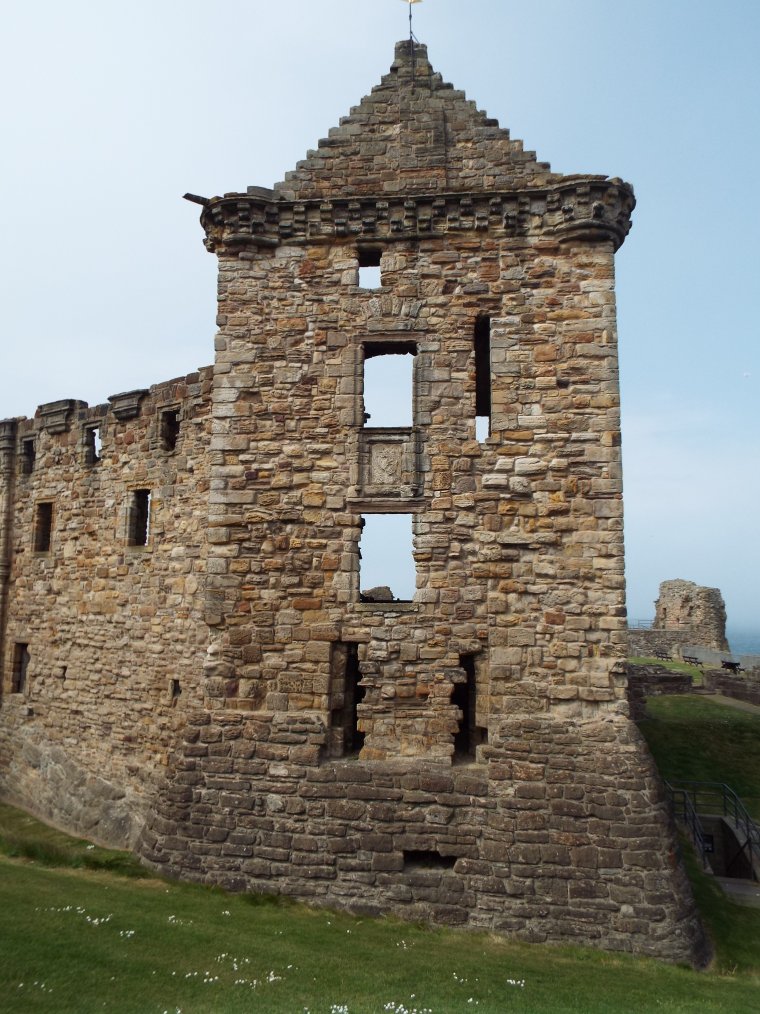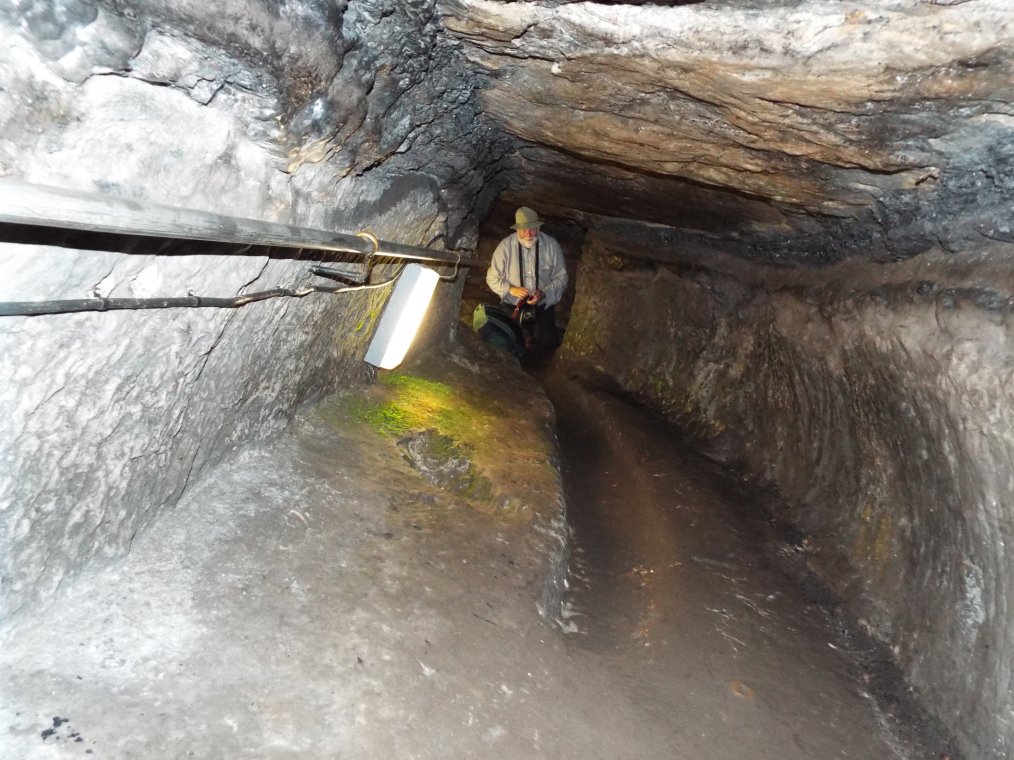St Andrews Castle

The fortress cum bishop's palace sits on a rocky promontory overlooking the North
Sea and may have been founded by Bishop Roger
Beaumont (1189-1202), a younger son of Earl Robert of Leicester
(d.1190). The later archbishops of St Andrews, when
writing from here, dated their letters and charters at the castle
as ‘our palace' (apud Palatium nostrum). Despite this, the castle
was not the first building on this location as an excavation of 1988-90
found evidence of prehistoric structures on the site.
Like many of the Scottish castles, St
Andrews only reaches the historical record with the fighting that
occurred from 1296 onwards, despite the fact that excavation has found
Bronze Age material on the site. In 1303 the castle was outfitted
for a visit from King Edward I. After Robert Bruce's victory
at Bannockburn in 1314, the castle was retaken and repaired by Bishop
William Lamberton (d.1328). The fortress was subsequently destroyed, for in 1335, according to Fordun,
King Edward Balliol (d.1364) had Henry Ferrers rebuild it before Earl David Strathbogie was killed at the battle of Culblean near Kildrummy that December.
As a result of the refortifications carried out by King Edward Balliol
at various places throughout Scotland, Andrew Moray (d.1338), acting as
regent of Scotland for King David II (d.1371), set about reducing these
strongholds. With the earls of March and Fife as well as William
Douglas, they attacked and destroyed Falkland tower and then marched on
St Andrews. After a siege lasting
three weeks and using various siege engines, one called Bowstower (Boustour),
the garrison surrendered on the last day of February 1336 to save their
lives and their members. The attackers then threw down the nobly
constructed walls and burned what remained. A later chronicle
claimed that they cast it doune. Once the slighting was done they moved on to besiege Bothwell, taking their siege engines with them.
The castle remained in this ruined state
until Bishop Walter Trail (1385-1401) rebuilt it at the turn of the
century. He seems to have completed his work on the castle by
1400 and died within its walls in 1401. On his death the duke of
Rothesay (d.1402) besieged the castle and nearby Reres castle.
The result was that by the end of 1401 the castle was prepared to
surrender to him. However, this may have been a ruse and in
attempting to ride to the castle from Edinburgh,
Rothesay was arrested by his own men for his arbitrary behaviour.
He then went to imprisonment first in the castle he was trying to take
and then in Falkland castle, where he was to die in March 1402.
King James I of
Scotland (1406-1437), the younger brother of Rothesay, received part of his education here from Bishop
Henry Wardlaw (d.1440), the founder of St Andrews University in 1410.
In 1445 the castle was the birthplace of James III of
Scotland (d.1488). The castle also played its part in the running of
the kingdom, being the prison for such prominent individuals as Duke
David Stuart of Rothesay in 1402, Duke Murdoch in 1425, and even
Archbishop Patrick Graham, who was judged to be insane and imprisoned
in his own castle in 1478.
During the Scottish Reformation, the
castle became a centre of religious persecution and
controversy. Referring to the castle's bottle dungeon the
Scottish reformer, John Knox, wrote, 'Many of God's Children were
imprisoned here'. In 1521 Archbishop James Beaton of
Glasgow (d.1539) was translated to St Andrews and took up residence in the
castle. He then altered the defences to enable the castle to
withstand a heavy artillery attack, which was a threat as tensions grew
between the Catholics and the English
supported Protestants. This work
consisted of 2 massive circular gun towers built
on the landward side and the equipping of the wallwalks for heavy
carriage mounted guns. The archbishop died in his episcopal
castle in February 1539 and was
succeeded by his ambitious and wealthy nephew, Cardinal David Beaton (d.1546). His strong opposition to the marriage of Mary
Queen of Scots, with Prince Edward (later King Edward VI), the son and
heir of Henry VIII of England, helped to spark renewed fighting in 1544 as the War of Rough Wooing.
In 1546 Beaton imprisoned the Protestant
preacher George Wishart (1513-1546) in the castle's sea tower and later had
him burnt at the stake in front of the castle walls on 1
March. On 26 May, Wishart's friends gained entry to the castle
by disguising themselves as masons working on the fortress. They overcame the garrison and murdered
Cardinal Beaton, hanging his body from a
castle window. Protestants then swarmed to the fortress and formed the first Protestant congregation in
Scotland. The Scottish regent, Earl
James Hamilton of Arran, appalled at the crime besieged the castle. In October 1546 a mine
was begun outside the gatehouse, but the defenders successfully
counter-mined it. Although Henry VIII made plans to assist the
Protestants, he died on 28
January 1547 and the Protestants were left to their fate.
In April 1547 John
Knox entered the castle to serve as the garrison's preacher for the
remainder of the siege. However, when a French fleet arrived
bringing an Italian engineer, Leone Strozzi, a devastating
artillery bombardment began. Guns were placed
on the towers of St Salvator and the cathedral. According to Robert
Lindsay of Pitscottie
the castle was then reduced within 6 hours. The garrison were
then deported, some to prison in France, others like Knox to serve on
the Spanish galleys as slaves.
 The
damaged castle was subsequently rebuilt by Archbishop John Hamilton
(d.1571). During the rebuilding his heraldic emblem, the 5
pointed star, was placed
above the rebuilt castle gate. The Scottish parliament separated the castle from
the archbishopric in 1606, when it was granted to the earl of Dunbar,
who had been constable since 1603. With the success of the Reformation in Scotland, the office of bishop was
finally abolished by William of Orange
in 1689. With this the castle was allowed to fall into total ruin. Indeed as early as 1656
the burgh council had ordered that its materials should be reused to repair the
pier.
The
damaged castle was subsequently rebuilt by Archbishop John Hamilton
(d.1571). During the rebuilding his heraldic emblem, the 5
pointed star, was placed
above the rebuilt castle gate. The Scottish parliament separated the castle from
the archbishopric in 1606, when it was granted to the earl of Dunbar,
who had been constable since 1603. With the success of the Reformation in Scotland, the office of bishop was
finally abolished by William of Orange
in 1689. With this the castle was allowed to fall into total ruin. Indeed as early as 1656
the burgh council had ordered that its materials should be reused to repair the
pier.
Description
The castle consists of an irregular enceinte set on the sea cliff. The original
entrance was through the Fore Tower and may date back to the twelfth century and was rebuilt for the same purpose in the late fourteenth century, apparently by Bishop Trial (d.1401).
The rectangular gatetower is standard for an eleventh or twelfth century
gatetower and, although not overly common, many other examples exist. Externally the gatetower has a fine fourteenth
century plinth, encasing the earlier tower. It has also been
refaced, although some of this facing has now been stripped away to
expose the remains of the original entrance and one of the long holes
which allowed a beam to pivot through it to raise and lower the
drawbridge. This design is more French than English. From
the side the two phase construction of the tower is even more clear,
with the red sandstone plinth, standing out strongly from the grey
stone of the original early tower. This is topped by the
fourteenth century red sandstone. The inner face of the gatetower
is now gone and a fourteenth century barrel vault has been added to the
gate passageway to make an undercroft.
Bishop Trial (d.1401) is thought to have added two more rectangular towers to the enceinte - the Kitchen and the Sea Tower to the north-east and north-west respectively.
The Sea Tower was some 20'x15' and once had 3 storeys. Little
remains today, but the basement and the infamous unlit bottle prison.
The Kitchen Tower was slightly larger than its compatriot and
housed the kitchen on its first floor as this had easy access to the
nearby hall. It is possible that Bishop Trial also built 2 more
towers to the south-east and south-west
under the sites of the later sixteenth century blockhouses of Cardinal
Beaton. The east wall of the castle has been eroded away by the
sea, taking with it many of the service buildings and the great hall.
The original chapel seems to have been just east of the Fore
Tower.
 The Beatons were probably responsible for making the Fore Tower into a
normal rectangular tower and making a new entrance to the castle
further west. This they did by building a new wall forward of the
old south-west curtain and linking it to the new round south-west blockhouse.
This new wall also mounted artillery both within and on top.
This certainly increased the defences of the vulnerable south
side of the castle. Such vulnerableness is emphasised by both
blockhouses seeming to have been heavily damaged in the siege of
1546-7. Indeed, only one gun loop remains in the last fragment of
the south-west blockhouse, while the south-east curtain and blockhouse have disappeared
in their entirety.
The Beatons were probably responsible for making the Fore Tower into a
normal rectangular tower and making a new entrance to the castle
further west. This they did by building a new wall forward of the
old south-west curtain and linking it to the new round south-west blockhouse.
This new wall also mounted artillery both within and on top.
This certainly increased the defences of the vulnerable south
side of the castle. Such vulnerableness is emphasised by both
blockhouses seeming to have been heavily damaged in the siege of
1546-7. Indeed, only one gun loop remains in the last fragment of
the south-west blockhouse, while the south-east curtain and blockhouse have disappeared
in their entirety.
During the siege of 1546-7 the Catholics mined
towards the castle from the safety of the town, making a fine spacious
tunnel large enough for pack animals to be used in clearing the debris
from their works. Internally the besieged made at least 3
attempts to break the mine. From the ditch outside the Fore Tower
a shaft can be entered which leads to a narrow shaft that breaks into
the oncoming mine. This action caused the attackers to halt their
attack. Two further abortive countermines can still be seen on
either side of
the current south-west entrance to the castle.
Why not join me at St
Andrews and other
Great Scottish Castles this Spring?
Information on tours at Scholarly
Sojourns.
Copyright©2019
Paul Martin Remfry


 The
damaged castle was subsequently rebuilt by Archbishop John Hamilton
(d.1571). During the rebuilding his heraldic emblem, the 5
pointed star, was placed
above the rebuilt castle gate. The Scottish parliament separated the castle from
the archbishopric in 1606, when it was granted to the earl of Dunbar,
who had been constable since 1603. With the success of the Reformation in Scotland, the office of bishop was
finally abolished by William of Orange
in 1689. With this the castle was allowed to fall into total ruin. Indeed as early as 1656
the burgh council had ordered that its materials should be reused to repair the
pier.
The
damaged castle was subsequently rebuilt by Archbishop John Hamilton
(d.1571). During the rebuilding his heraldic emblem, the 5
pointed star, was placed
above the rebuilt castle gate. The Scottish parliament separated the castle from
the archbishopric in 1606, when it was granted to the earl of Dunbar,
who had been constable since 1603. With the success of the Reformation in Scotland, the office of bishop was
finally abolished by William of Orange
in 1689. With this the castle was allowed to fall into total ruin. Indeed as early as 1656
the burgh council had ordered that its materials should be reused to repair the
pier. The Beatons were probably responsible for making the Fore Tower into a
normal rectangular tower and making a new entrance to the castle
further west. This they did by building a new wall forward of the
old south-west curtain and linking it to the new round south-west blockhouse.
This new wall also mounted artillery both within and on top.
This certainly increased the defences of the vulnerable south
side of the castle. Such vulnerableness is emphasised by both
blockhouses seeming to have been heavily damaged in the siege of
1546-7. Indeed, only one gun loop remains in the last fragment of
the south-west blockhouse, while the south-east curtain and blockhouse have disappeared
in their entirety.
The Beatons were probably responsible for making the Fore Tower into a
normal rectangular tower and making a new entrance to the castle
further west. This they did by building a new wall forward of the
old south-west curtain and linking it to the new round south-west blockhouse.
This new wall also mounted artillery both within and on top.
This certainly increased the defences of the vulnerable south
side of the castle. Such vulnerableness is emphasised by both
blockhouses seeming to have been heavily damaged in the siege of
1546-7. Indeed, only one gun loop remains in the last fragment of
the south-west blockhouse, while the south-east curtain and blockhouse have disappeared
in their entirety.